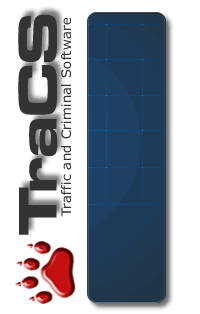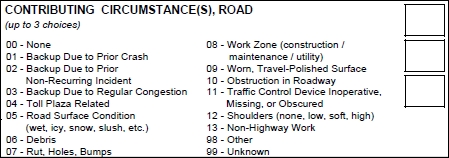

Select up to three road conditions that may have contributed to the crash.
00 - None select this option if there are no road or prior events that may have contributed to the crash.
01 - Backup Due to Prior Crash is used when the contributing circumstance to the crash is an accumulation of traffic leading to congestion caused by vehicles slowing or stopping because of an earlier crash on either side of the road.
02 - Backup Due to Prior Non-Recurring Incident is used when the contributing circumstance to the crash is an accumulation of traffic leading to congestion caused by vehicles slowing or stopping because of an irregular event other than a crash such as debris in the roadway or a police vehicle having pulled over another vehicle to the side of the road (either side).
03 - Backup Due to Regular Congestion is used when the contributing circumstance to the crash is an accumulation of traffic caused by vehicles slowing or stopping due to a normal high volume of traffic on the road, such as during rush-hour traffic.
04 - Toll Plaza Related. Toll booth/plaza related crashes are either related to or occur within the upstream of approach area and ends immediately before the roadway starts to widen leading up to the toll booths; in the approach area where the roadway starts to widen up to its maximum number of lanes; at the toll plaza area that begins when the roadway has reached its maximum number of lanes, includes the toll booth(s), and ends immediately before the roadway begins to narrow; in the departure area that begins when the roadway begins to narrow after the toll plaza and ends immediately before the roadway reaches its normal number of lanes; or, the downstream of departure area, which begins as soon as the roadway has resumed its normal number of lanes. See the following image:

TOLL PLAZA RELATED
Source: FHWA
06 - Debris is used when there is debris on the road that may have contributed to the crash.
07 - Rut, Holes, Bumps is used when there are ruts, holes, or bumps in the road that may have contributed to the crash.
08 - Work Zone (construction / maintenance / utility). A work zone is an area of a trafficway where construction, maintenance, or utility work activities are identified by warning signs/signals/indicators, including those on transport devices (e.g., signs, flashing lights, channelizing devices, barriers, pavement markings, flagmen, warning signs and arrow boards mounted on the vehicles in a mobile maintenance activity) that mark the beginning and end of a construction, maintenance or utility work activity. A work zone extends from the first warning sign, signal or flashing lights to the END ROAD WORK sign or the last traffic control device pertinent to that work activity. Work zones also include roadway sections where there is ongoing, moving (mobile) work activity, such as lane line painting or roadside mowing, only if the beginning of the ongoing, moving (mobile) work activity is designated by warning signs or signals.
09 - Worn, Travel-Polished Surface is used when the road surface is well-used and shiny and this condition might have contributed to the crash.
10 - Obstruction in Roadway is used when there is a blockage in the roadway that might have contributed to the crash.
11 - Traffic Control Device Inoperative, Missing, or Obscured is used when the traffic control device was inoperative, missing or obscured. The roadway used for coding this field is the one this vehicle departed from if it is off the roadway just prior to its critical pre-crash event. If this vehicle is in a junction just prior to its critical pre-crash event, this field should be filled out based on the roadway this vehicle was on before entering the junction.
12 - Shoulders (none, low, soft, high) – select this option when no shoulder exists, the shoulder is too low, the shoulder is too soft, or the shoulder is too high and this might have contributed to the crash.
13 - Non-Highway Work is used if maintenance or other types of work is occurring near or in the trafficway but not related to the trafficway and this might have contributed to the crash.
98 - Other use this option for any other road circumstance that may have contributed to the crash and is not listed in the options above for this field.
99 - Unknown should be selected when it is unknown if there were any road circumstances that may have contributed to the crash.